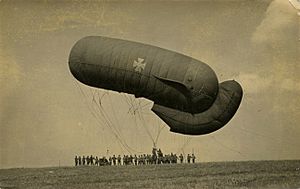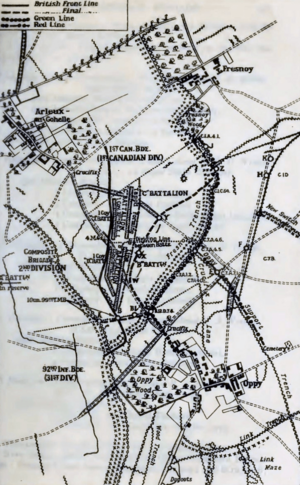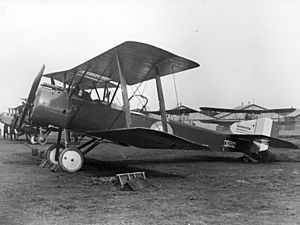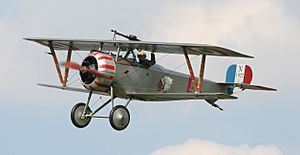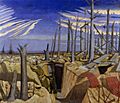Capture of Oppy Wood facts for kids
Quick facts for kids Capture of Oppy Wood |
|||||||
|---|---|---|---|---|---|---|---|
| Part of the Battle of Arras (1917) in the First World War | |||||||
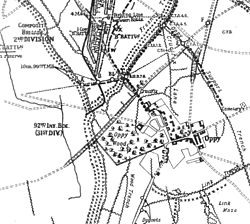 Oppy Wood defences, 1917 |
|||||||
|
|||||||
| Belligerents | |||||||
|
|||||||
| Commanders and leaders | |||||||
| Sir Douglas Haig Henry Horne |
Ludwig von Falkenhausen Otto von Below Fritz von Lossberg |
||||||
| Strength | |||||||
| 2 divisions | 1 division, 1 regiment | ||||||
| Casualties and losses | |||||||
| 452 | c. 566 | ||||||
| British casualties at Oppy Wood on 3 May were 2,417; German casualties at Fresnoy on 8 May were 1,585 | |||||||
The Capture of Oppy Wood was an important battle during the First World War. It happened on the Western Front in France on June 28, 1917. The battle was part of the larger Battle of Arras.
Oppy Wood was a small forest, about one acre in size. It was very important because it overlooked the British army's positions. The Germans had made it a strong fortress with observation posts, machine-gun nests, and trench mortars. They used new defensive tactics to hold onto it.
The British tried to capture Oppy Wood earlier, on May 3, but they failed. This first attack was very costly. The Germans had strong defenses and didn't need extra troops to fight off the British.
A second, more successful attack happened on June 28. This attack was a feint (a trick) to make the Germans think the British were planning a big attack on the cities of Lens and Lille. The British captured their targets with few losses. German counter-attacks were stopped by heavy artillery fire. These attacks did not fool the Germans about the main British plans in Flanders, but they did help the French army further south.
Contents
Why the Battle Happened
British Army Plans
After some earlier battles, the British commander, Sir Douglas Haig, decided to keep fighting around Arras. His goal was to get to a better defensive line. He also wanted to launch surprise attacks to keep German soldiers busy in the area.
The British army was also preparing for a big attack in Flanders, a region in Belgium. This attack, the Battle of Messines, was planned for early June. To help with this, the British planned smaller attacks near Lens and Lille in late June. These attacks were meant to distract the German army.
German Army Defenses
The German army had learned a lot from earlier battles, like the Battle of the Somme in 1916. They had new ideas about how to defend their positions. One important idea was to have "relief" divisions ready to counter-attack quickly.
They also organized their army corps into permanent areas. This meant that any new divisions moving into an area would report to the local corps headquarters. This helped them keep their defenses strong and organized.
Preparing for Battle
British Preparations
The British army planned their attack carefully. They wanted to attack at dawn, but the moon was still out, making it hard to see. They also planned to attack German observation balloons. These balloons were used by the Germans to spot British movements. Nieuport Scout planes from the Royal Flying Corps (RFC) were used for this.
Oppy Wood was a difficult place to attack. It was full of fallen trees and branches, making it hard to move through. The British artillery also had trouble reaching it because of the long slope. To help, they brought in extra machine-guns.
The British also tried a small raid on June 22. This was to hurt the Germans and learn more about their defenses. The raid was successful, with few British losses.
German Preparations
The Germans had set up their defenses in specific areas. The VIII Reserve Corps was in charge of the area north of Givenchy. The I Bavarian Reserve Corps held the front from Givenchy to the Scarpe river.
The 1st Guard Reserve Division and the 15th Reserve Division were defending the Oppy Wood area. They were well-prepared for any British attack.
The Battle of Oppy Wood
First Attack: May 3
On May 3, the British attacked German observation balloons. They shot down four and damaged four more. The ground attack began with British soldiers forming up in the moonlight. The Germans saw them and started shelling the British positions before the attack even began.
When the British advanced, German rockets and flares lit up the battlefield. This made it easy for German machine-guns to fire at the British. Many British soldiers were caught in barbed wire and suffered heavy losses. They were either captured or forced to retreat. Some soldiers were stuck in no man's land all day under fire.
The British also attacked near Fresnoy. Some units reached their goals, but German counter-attacks pushed them back. The battle was very tough, and the British did not achieve their main goals that day.
Second Attack: June 28
The weather was dull and humid on June 28. At 5:30 p.m., German artillery shelled the British trenches for ten minutes. This caused about 200 casualties before the attack even started.
At 7:00 p.m., the British began a huge artillery bombardment. This was part of their trick to make the Germans think a big attack on Lens was coming. Howitzers fired smoke shells to create a screen. Then, a thunderstorm began, and the British infantry advanced in lightning and heavy rain.
The British soldiers moved quickly across no man's land, right behind their own artillery fire. They reached the German trenches before the German counter-barrage could hit them. The Germans were caught by surprise. The British captured their targets easily, taking many prisoners and machine-guns. The new positions gave the British a good view of the surrounding area.
German Counter-attacks
On May 3, the German divisions holding the front line were strong enough to stop the British attacks. They didn't need to call for their special counter-attack divisions. Small counter-attacks by German companies were often enough to push the British back.
Fresnoy was captured by Canadian troops. The Germans quickly counter-attacked but were pushed back. On May 8, the Germans launched a planned counter-attack to retake Fresnoy. They used many soldiers and artillery. Despite heavy fighting, the Germans managed to recapture Fresnoy, but they suffered many casualties.
Air Operations
After April 1917, which had been a very bad month for British aircraft, air battles moved behind German lines. British pilots practiced flying low to surprise German observation balloons. These balloons were hard to shoot down because they could be quickly pulled down.
On May 2, British planes from 40 Squadron attacked the balloons. They shot down four and damaged four more. All the British planes returned, but they were damaged by German small arms fire.
On May 3, British planes were used to spot German counter-attacks. They flew low over the battlefield, looking for any signs of German troops gathering. When they saw German soldiers, they would machine-gun them from low altitudes. They also bombed railway stations and airfields. At night, planes from 100 Squadron continued bombing trains and railway junctions.
After the Battle
Casualties
On May 3, the British 31st Division lost about 1,900 soldiers in the attack on Oppy Wood. The 2nd Division also suffered about 517 casualties. On May 8, the German 5th Bavarian Division lost 1,585 soldiers in the counter-attack at Fresnoy.
In the successful attack on June 28, the British had fewer losses. The 31st Division had about 100 casualties, and the 5th Division had 352.
Later Events
After the battle, the British continued to push their lines closer to the German front. This was to avoid German artillery fire. They also moved some artillery batteries forward to increase their impact. The British kept up bombardments to make the Germans worried about another attack.
The British positions around the windmill were often shelled by German artillery. However, the infantry positions were safe. The German shells mostly hit the British artillery instead.
See also
Victoria Cross
- 2nd Lieutenant Jack Harrison, 11th E. Yorks.
Commemoration
The units that fought at Oppy Wood were given the battle honour Oppy. A forest in Hull, Yorkshire, is named Oppy Wood. This is to remember the soldiers from the East Yorkshire Regiment who died in the attack on May 3.
Images for kids


